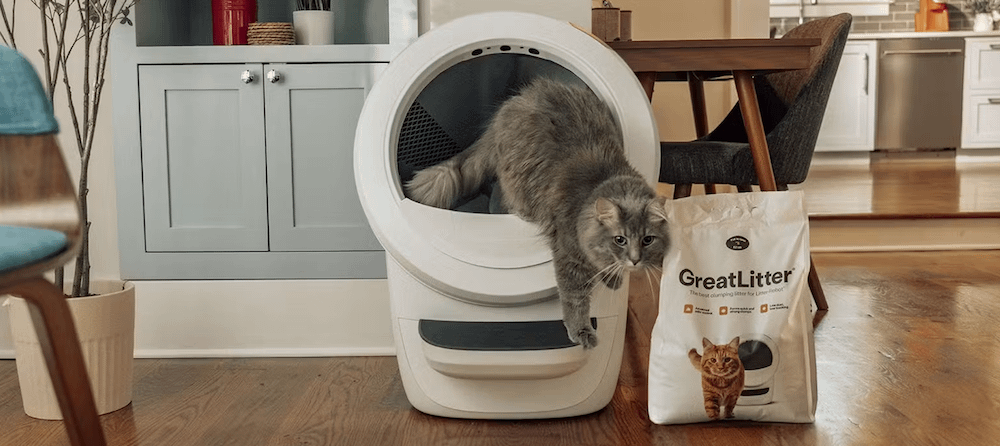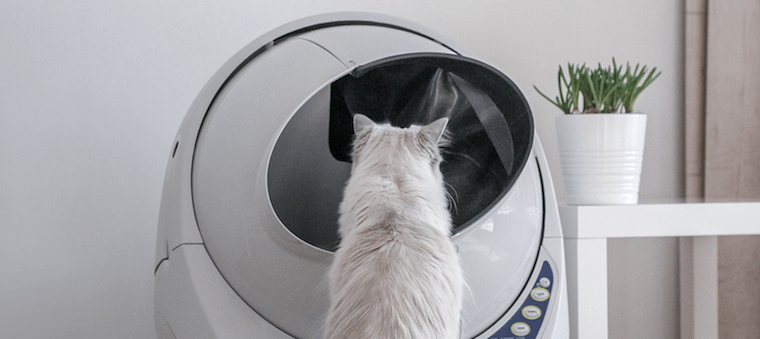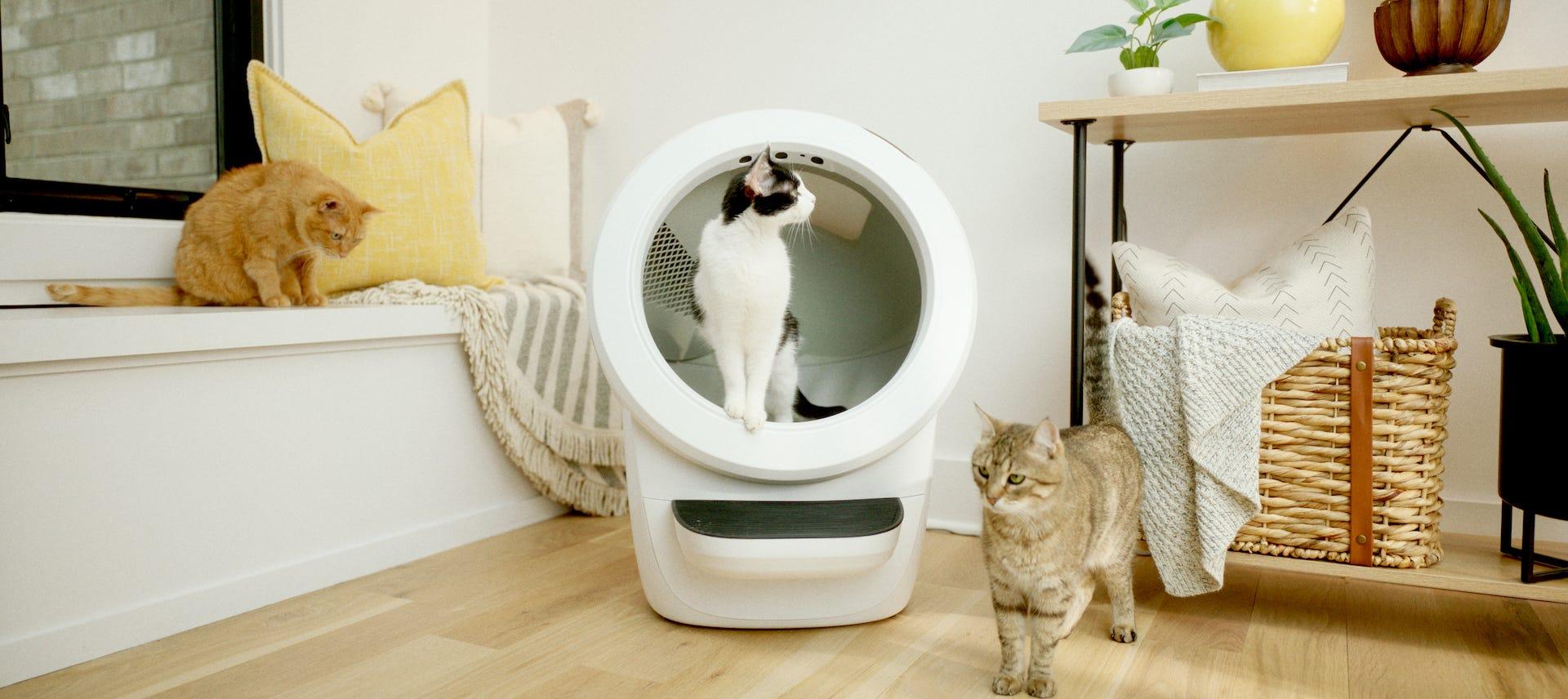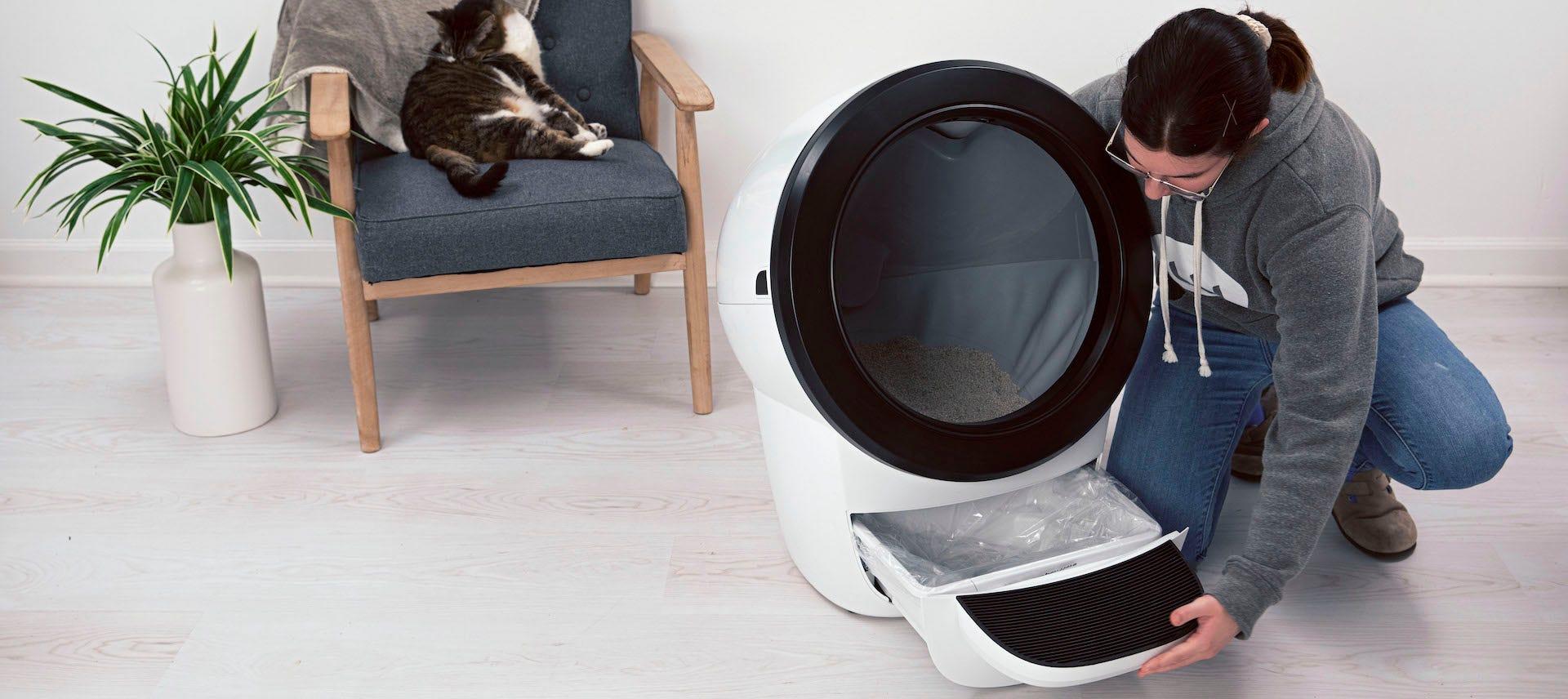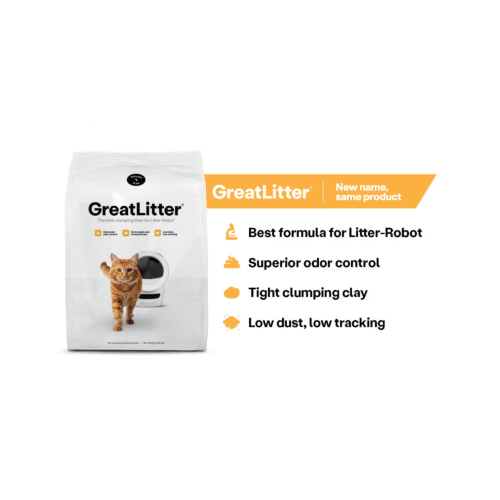Litter-Robot might seem like a miracle device to some cat parents, but its self-cleaning magic comes down to the unit’s simple yet elegant engineering. Through a combination of time, rotation, and gravity, the patented sifting process separates your cat’s waste from the clean litter depositing it into a drawer below. Impressive design aside, we shouldn’t overlook the one thing that holds it all together: litter! To get the best experience for your feline friend AND for yourself, it’s important to make sure you’re buying the best litter for Litter-Robot. So let’s discuss how to pick the best litter for your new Litter-Robot.
Clay-clumping cat litter
In order to separate your cat’s waste from the clean litter, our self-cleaning litter box works best with clumping cat litter. Although any clumping litter works, high-quality clay-clumping litter equates to tighter clumps, which leads to less mess in the litter box.
Litter-Robot has flexible cycling options: With Litter-Robot 3 Connect, you can set it to cycle 3, 7, or 15 minutes after your cat exits; with Litter-Robot 4, you can set it at 3, 7, 15, 25, or 30 minutes. You may want to set the timer to 3 minutes if you have dogs roaming the house for “treats.” With a high-quality clumping litter, you can rest assured that the clumps have tightened up quickly, allowing you to use that 3-minute timer setting.
Low-dust, low-tracking cat litter

Imagine eagerly preparing a fresh bed of litter, only to be greeted by an unwelcome cloud of dust. The best litter for Litter-Robot is a low-dust clumping litter, which helps prevent your cat from spreading dust around your home. Additionally, Litter-Robot 4 comes equipped with a LowDust screen, ensuring that the patented sifting process further minimizes litter dust during each cycle.
Unscented cat litter
One of Litter-Robot’s unique selling points is its ability to help reduce or even eliminate litter box odors. By depositing the waste into a sealed drawer below, the usual unpleasant smells tend to be drastically reduced. However, some cats are simply “stinkier” than others (based on diet, health conditions, and even breed)—and you still might need a little help reducing litter box odors.
It's a common misconception that scented litter is the solution to this problem. Scented litters, with their added perfumes, merely mask the smell instead of eliminating it. Moreover, research indicates that most cats have a preference for unscented litter. So if your cat stops using the litter box due to its imposing fragrance, you’ve got another problem on your hands!
Note: Some cats aren't bothered by lightly scented litters. Stick with what you know works for your cat.

All-natural cat litter
Speaking of litter with added perfumes or chemicals… skip those! The best litter for Litter-Robot is the all-natural kind, with no additives and as few ingredients as possible. This isn’t just about what’s best for Litter-Robot—it’s about what’s best for your cat.
Recommended and non-recommended litter brands for Litter-Robot
Litter-Robot’s system requires clumping litter. Litter beads and crystals that are small enough to pass through the screen will also work. However, translucent or white-colored litter (most often seen in crystal litter) may impact the litter level and Drawer Full Indicator (DFI) accuracy in Litter-Robot 4. Cat litters that are strictly absorbent, non-clumping, loose-clumping, newspaper-based, or wood-based pellets should NOT be used.
Litter brands that will work properly with Litter-Robot
- GreatLitter®. Officially recommended litter, designed by Whisker specifically for Litter-Robot. Better odor control and will not stick to the liner inside.
- Tidy Cats® Designed for Litter-Robot®. Specially formulated for Litter-Robot and The Perfect Cycle™. Note that this litter features a revitalizing scent, but the fragrance is only activated by motion (i.e., when Litter-Robot cycles).
- Fresh Step cat litter. Heavy litter. We recommend keeping 1/2 inch below fill line.
- Dr. Elsey cat litter. Heavy litter. We recommend keeping 1/2 inch below fill line.
- Scoop Away cat litter. Heavy litter. We recommend keeping 1/2 inch below fill line.
- Sustainably Yours cat litter. Fast clumping. Use a large grain version for less litter tracking.
- Pretty Litter. Crystal-based, will work in Litter-Robot 3. Will NOT work with Litter-Robot 4 (see below).
- Arm & Hammer Naturals. Corn-based, clumping cat litter. Will work in Litter-Robot.
- Naturally Fresh cat litter. Walnut-based, only the clumping kind will work.
- Tofu litter. Some brands will work with Litter-Robot.
Litter brands that WILL NOT WORK properly with Litter-Robot
- Skoon cat litter. Non-clumping clay litter.
- Feline Pine cat litter. Pellets, will not sift in Litter-Robot.
- Pretty Litter. Not recommended for Litter-Robot 4: Translucent or white-colored litter (most often seen in crystal litter) will impact the accuracy of litter and waste level readings.
- Purina Yesterday's News cat litter. Paper-based and will not sift properly as most are non-clumping.
- Okocat litter. Wood and paper pellets, will not sift in Litter-Robot.
- Catit Pea Husk Litter. Pellet-shaped. Will not sift properly in Litter-Robot.
- Tuft & Paw Really Great Cat Litter. Tofu litter, will not sift properly in Litter-Robot.
- Paco and Pepper Olive Pits Cat Litter. May stick to the globe liner. In addition, this cat litter creates a significant amount of residue left over and wasted litter after a cycle due to the way it clumps.
The best litter for Litter-Robot
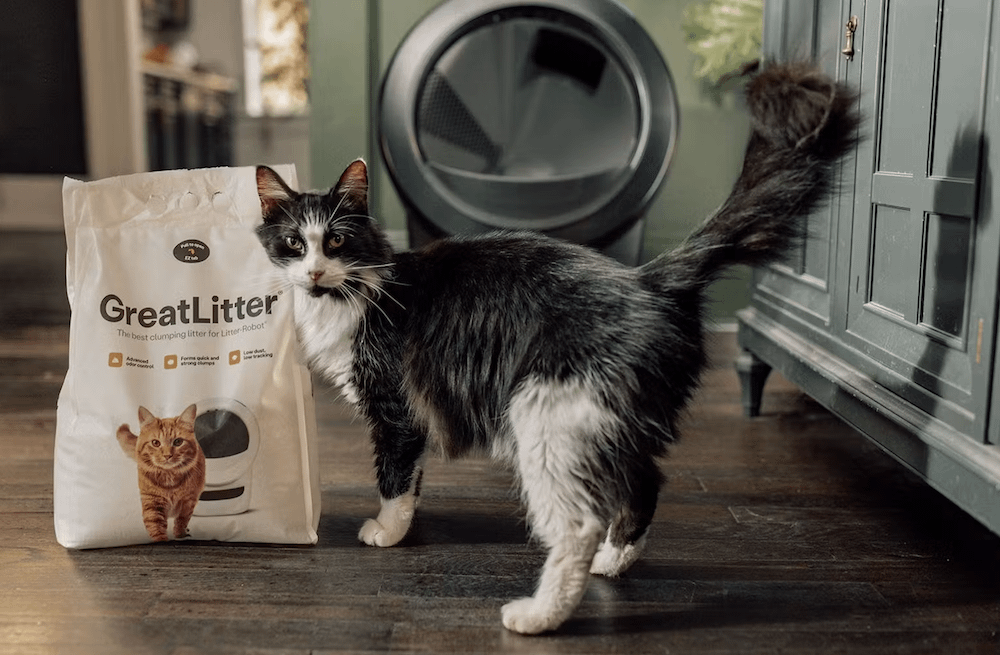
The best litter for Litter-Robot should meet all the qualities listed above. And there are two cat litters out there that do this! GreatLitter® and Tidy Cats® Designed for Litter-Robot® are both:
- High-quality clay-clumping litter: Each granule is just right; not too big and not too small. When a clump forms, the uniform granules pack together efficiently and hold tight.
- Low-dust, low-tracking litter: By sun-drying the clay, preserving its soft texture and then screening it for ideal particle size, our cat litter is very low-dust making it one of the best low tracking litter packages around.
- Litter that locks in odors: Our cat litter is the most efficient at drawing up liquid and sequestering that telltale ammonia scent caused by urine degrading in the litter box.
- All-natural litter: This litter has just one all-natural ingredient—sodium bentonite, dried with the power of the sun. There are no additives or fillers.
These cat litters were designed for our self-cleaning litter boxes, making it the best litter for Litter-Robot. If you're looking for a cat litter that doesn't track, provides better odor control, and reduces litter dust, these are it! See what our customers say about it:
I love this kitty litter because it’s all natural, no perfumes! It lasts a long time because it completely encapsulates the waste and deposits it into the bag which keeps the remaining kitty litter clean and dry! I just add more when it runs low. Most importantly my cat loves it. It’s a bit more expensive but equates to savings because it lasts longer. Highly recommend. - Edward L
Other benefits of GreatLitter®
GreatLitter® isn’t just good for your Litter-Robot and your cat. It’s great for you, as well!
To further help you decide what's best for your cat, check out our full litter box guide.

Delivered to your door
Skip the store: You’ll quickly get used to the convenience of not having to visit a pet store, lug around a heavy box of litter, and haul it inside your home. Our litter is delivered right to your doorstep. No travel or interaction required!
Flexible subscription options
Set it and forget it: You can subscribe to our litter, so you no longer have to keep cat litter on your shopping list. Subscription options are flexible, too: Choose from 20-lb., 40-lb., and 60-lb. bags delivered monthly, bimonthly, or quarterly.
Harvested in the USA
Our partner’s family-owned-and-operated ranch is located in the geographic center of the world’s only supply of high-quality sodium bentonite clay—Wyoming, USA! This gives us access to superior raw material for cat litter.
So, now you know: GreatLitter® and Tidy Cats® Designed for Litter-Robot® are the best litters for Litter-Robot!
How much litter should you use in Litter-Robot?
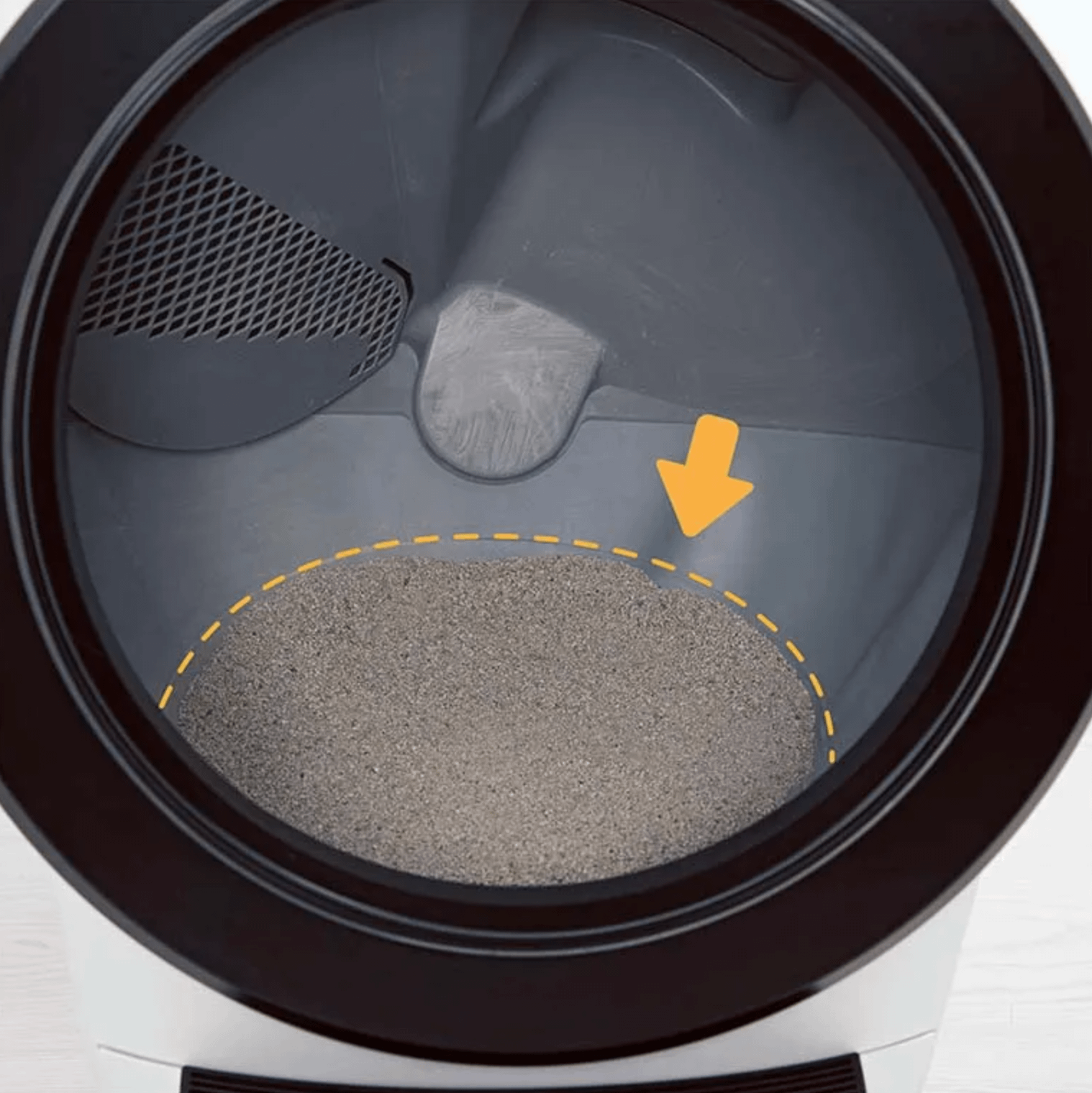
Once you’ve picked the ideal litter for your Litter-Robot, it’s important to make sure you’re not over-filling or under-filling your cat’s self-cleaning litter box.
The optimal litter bed level inside Litter-Robot is at or just below the fill line inside the globe.
You can also use LitterHopper to keep optimal litter levels after each use.
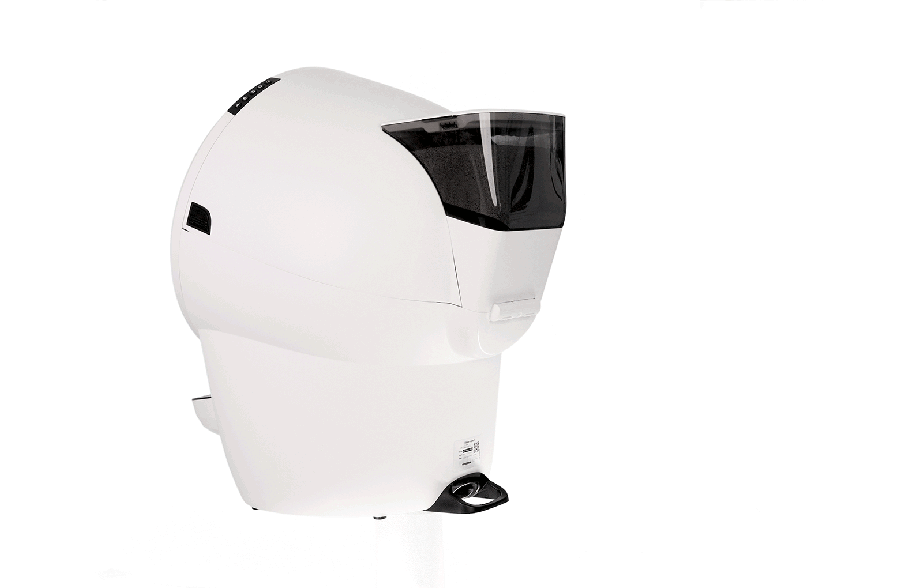
Holding up to 13 cups of litter, LitterHopper automatically dispenses litter into the globe as needed and maintains the recommended litter bed level. This represents over 2 weeks without refilling litter when used in a single-cat household.
LitterHopper is compatible with multiple litter types, including clay and silica but we recommend using clay-clumping cat litter to ensure litter level and waste levels are detected accurately.
